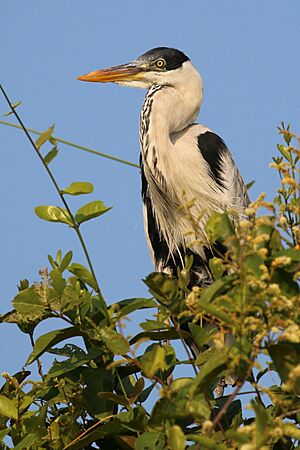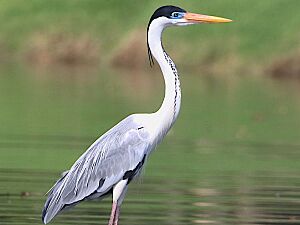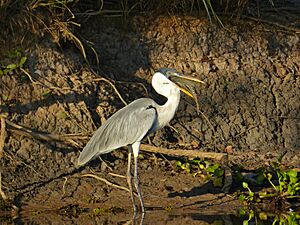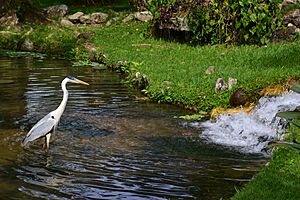Cocoi heron facts for kids
Quick facts for kids Cocoi heron |
|
|---|---|
 |
|
| In the Pantanal, Brazil | |
| Conservation status | |
| Scientific classification | |
| Genus: |
Ardea
|
| Species: |
cocoi
|
 |
|
| Global range | |
The cocoi heron (Ardea cocoi) is a tall, elegant bird found across South America. It's a type of heron, known for its long legs and its love for shallow water. This bird has mostly light grey feathers with a darker grey tuft on its head. It's a meat-eater, hunting fish and crabs in shallow water.
Contents
About the Cocoi Heron
What's in a Name?
The cocoi heron was first described by Carl Linnaeus in 1766. He was a famous scientist who named many plants and animals. We don't know exactly where the name "cocoi" comes from. It might be linked to the bird's call, which sounds like "cuca" in Chile. In South America, people often call it garza mora, which means "black heron".
Family Ties: Heron Relatives
The cocoi heron is part of a special group called a superspecies. This means it's very similar to other herons around the world. Its close relatives include the grey heron from Africa, Europe, and Asia. It's also related to the great blue heron found in North and Central America. These herons look alike and have similar body structures.
How to Spot a Cocoi Heron

Size and Appearance
The cocoi heron is the biggest heron in South America. It can stand from about 95 to 130 cm (37 to 51 in) tall. Birds from southern areas tend to be the largest. An adult cocoi heron can weigh between 1.14 to 3.2 kg (2.5 to 7 lb). Its wings can spread up to 455 mm (18 in) long.
Both male and female cocoi herons look the same. They have a grey back and upper wings. Their neck, thighs, and under-tail feathers are white. You'll see black stripes on their neck and upper chest. The top of their head and forehead are black. This black color goes down to their eyes and forms a pointed crest. They also have black patches on their lower chest and belly. Their legs can be black, brownish-grey, or dark green.
Eyes, Beak, and Flight
The cocoi heron usually has yellow eyes. Its beak is a dull yellow. The skin around its eyes is a pale greenish color. During breeding season, some herons in Argentina have bright yellow beaks with a red tint. Their legs can turn a dusky pink.
When it flies, the cocoi heron uses its large wings. It's a slow but graceful flyer. Its voice is a deep, croaking sound. The cocoi heron looks a lot like the grey heron. However, the cocoi heron is a bit darker. It also has a longer neck and crest.
Young Herons
Young cocoi herons look a bit different from adults. Their undersides are ash grey with buff streaks. Their neck and upper body are pale brownish. Their head is duller than an adult's. Young herons also don't have the long plumes or crest that adults do. Even as tiny chicks, they show the dark head and pale neck that adults have.
Comparing with Similar Birds
In some places like Colombia and Panama, the cocoi heron lives near the great blue heron. The great blue heron is also a large, related bird. You can tell the cocoi heron apart by its bright white neck and solid black head. Young herons are harder to tell apart because their colors are duller.
Where Cocoi Herons Live
Their Home Range
The cocoi heron lives across most of South America. You won't find it in the high Andes mountains or some parts of Argentina. It lives in countries like Argentina, Panama, Suriname, Colombia, Venezuela, Bolivia, Brazil, Chile, Ecuador, French Guiana, Guyana, Paraguay, Peru, and Uruguay.
This bird is very widespread. It ranges from Central America all the way to the Strait of Magellan. However, it's rare to see them further south than Chubut in Argentina. Their total living area is huge, about 20.6 million square kilometers. Sometimes, they visit places like the Falkland Islands or Trinidad and Tobago.
Preferred Places to Live
Cocoi herons like almost any body of water or wetland. They avoid dense forests. You can find them by lake shores, in swamps, along rivers, and in estuaries. They also feed in grasslands and on beaches. They don't seem to like pastures much. This is probably because pastures have more insects, which they don't eat as much as fish. In the Falkland Islands, they like small streams. They can live at high places, up to 2,550 meters (8,366 ft) above sea level.
Cocoi Heron Life and Habits
What They Eat
Cocoi herons mainly eat fish that are over 20 cm (8 in) long. They also eat small mammals, amphibians, and sometimes insects. Some fish they eat include whitemouth croaker and wolf fish. They have also been seen eating dead animals and blue crabs. In Colombia, young chicks are mostly fed fish, with some amphibians and crabs.
How They Hunt
This heron catches its food by quickly striking its head into the water. It uses its beak to stab downwards. Sometimes, it just tilts its head so only its beak is in the water. When hunting, its head and neck move fast, but its body stays still.
Cocoi herons usually hunt during the day and alone. However, in Chile, they are thought to hunt mostly at night. During the day, they rest in trees near the water. In Venezuela, they have been seen hunting in large groups. When they hunt during the day, they are most active around noon.
Herons can find food far from their nests. They might eat land animals like rodents and reptiles. They also eat sea creatures if they live near the coast. Herons often choose nesting spots close to good hunting areas. They might even eat fish that fishermen throw away.
Raising a Family
Cocoi herons can live for about 10.5 years on average. Some can live up to 24.4 years. These birds usually don't migrate, meaning they stay in one place. But they might move closer to the equator in winter to find warmer weather.
The nesting season starts at different times depending on the location. In Suriname, it begins in July. In Brazil and Argentina, it's from August to November. Cocoi herons build their nests in trees, often in groups. Their nests are large and deep. They are made from branches and sticks, lined with grass. Nests can be about 65 cm (26 in) wide.
The eggs are pale blue with lighter spots. They are about 62-69 mm (2.4-2.7 in) long. An egg can weigh 70-80 grams (2.5-2.8 oz). It takes about 24-29 days for the eggs to hatch. A female heron usually lays 1 to 4 eggs. Young herons can stay in the nest for up to 12-13 weeks. However, most leave when they are 6 to 7 weeks old.
Dangers They Face
Besides human activity, one natural danger for cocoi herons is the crested caracara. These birds are predators. In one area, caracara chicks hatched before the heron chicks. The caracara young were then fed mostly heron chicks.
Protecting the Cocoi Heron
The cocoi heron is listed as a species of least concern by the IUCN. This means it's not currently in danger of extinction. This is because it lives in a very large area. Its population seems to be stable and there are many of them.
Some herons are affected by farm chemicals and changes to their environment. People sometimes disturb their nests and eggs. However, these problems are not severe enough to threaten the entire species.




